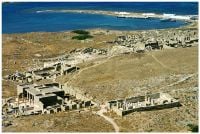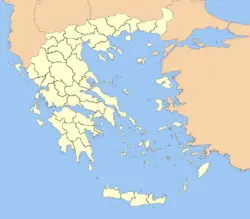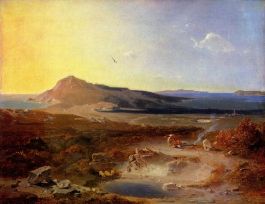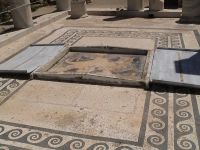Delos
| Delos (Δήλος) | |
|---|---|
 Delos | |
| Location | |
| Coordinates | Coordinates: |
| Time zone: | EET/EEST (UTC+2/3) |
| Elevation (min-max): | 0 - 11 m (0 - 36 ft) |
| Government | |
| Country: | Greece |
| Periphery: | South Aegean |
| Prefecture: | Cyclades |
| Population statistics (as of 2006) | |
| Municipality | |
| - Population: | 0 |
| - Area: | 40 km² (15 sq.mi.) |
| - Density: | 0 /km² (0 /sq.mi.) |
| Codes | |
| Delos* | |
|---|---|
| UNESCO World Heritage Site | |
Column with phallus at the Stoibadeion | |
| State Party | |
| Type | Cultural |
| Criteria | ii, iii, iv, vi |
| Reference | 530 |
| Region** | Europe and North America |
| Inscription history | |
| Inscription | 1990 (14th Session) |
| * Name as inscribed on World Heritage List. ** Region as classified by UNESCO. | |
The island of Delos (Greek: Δήλος, Dhilos, meaning "clear", or "brought to light"") is in the center of the roughly circular ring of islands called the Cyclades, near Mykonos. Established as a cult center, Delos was a holy sanctuary for a millennium before Olympian Greek mythology made it the birthplace of Apollo and Artemis. From its Sacred Harbor can be seen Mount Kynthos, which is crowned with a sanctuary of Dionysus.
Delos is the geographic and spiritual heart of the Cyclades. Just as the Sanctuary at Delphi is sacred to Apollo, so is this barren, windswept island sacred to its gods. The beautiful myth states that, Delos, the island of sun, appeared from amid waves when Leto, who was being pursued by Hera, took refuge there and brought Apollo and Artemis into the world. The birth of Apollo, the god of sun, on this island, is undoubtedly related to the morphology of Delos.
The island's first inhabitants were Carians, whose settlements date back to the third millennium B.C.E.. At the beginning of the tenth century B.C.E., after the Ionians had arrived on the island, Delos was transformed into a religious center, developed commercially, and increased its political influence. By the middle of the sixth century B.C.E., Athenians dominated not only Delos, but also the majority of Aegean Islands. Around 540 B.C.E., Pisistratus, the tyrant of Athens, ordered the removal of all graves from Delos to the small island nearby, called Rheneia. Since then, all births and burials were banned on Delos, in order not to desecrate the sacred place. The domination of Athenians over the island ended when Macedonians arrived on Delos in 315 B.C.E. Their presence signaled the island's independence and its commercial growth and wealth.
Delos was conquered by the Romans who declared it a free port, transforming the island into an important trade center. It attracted Egyptians, Syrians, and Italians. During the war declared by King Mithridates VI of Pontus (88 B.C.E.), Delos was attacked twice and from that moment began a countdown that resulted to the island's total depopulation.
Since 1873, the Ecole Française d'Athenes ("French School of Athens") has been excavating the island, whose complex of buildings compares with those of Delphi and Olympia.
In 1990, UNESCO inscribed Delos on the World Heritage List, citing it as the "exceptionally extensive and rich" archaeological site which "conveys the image of a great cosmopolitan Mediterranean port."
Setting
Delos is a 15-square-mile island, rocky and barren, where light dominates from the first moments of the breaking day until dusk. There are neither high mountains, nor the shade from trees, to shut out the light's perfect reflection. The ruins of the Delos settlement—the surviving marble columns, the theater, the gymnasium, as well as the pieces of important mosaic artwork—are spread about all over the island, giving testimony to the island's glorious history.
History
Investigation of ancient stone huts found on the island indicate that it has been inhabited since the third millennium B.C.E.. Thucydides identifies the original inhabitants as piratical Carians who were eventually expelled by King Minos of Crete. By the time of the Odyssey, the island was already famous as the birthplace of the twin gods Apollo and Artemis. Indeed, between 900 B.C.E. and 100 C.E., sacred Delos was a major cult center, where Dionysus is also in evidence as well as the Titaness Leto, mother of the above mentioned twin deities.
As a cult center, Delos had an importance that its natural resources could never have offered. In this vein Leto, searching for a birthing-place for Apollo, addressed the island:
- Delos, if you would be willing to be the abode of my son Phoebus Apollo and make him a rich temple —; for no other will touch you, as you will find: and I think you will never be rich in oxen and sheep, nor bear vintage nor yet produce plants abundantly. But if you have the temple of far-shooting Apollo, all men will bring you hecatombs and gather here, and incessant savour of rich sacrifice will always arise, and you will feed those who dwell in you from the hand of strangers; for truly your own soil is not rich.
- —Homeric Hymn to Delian Apollo
Another expression of Athenians' religious respect towards Apollo, was the festival, which was being organized in honor of the island's god every five years.
A number of "purifications" were executed by the city-state of Athens in an attempt to render the island fit for the proper worship of the gods. The first took place in the sixth century B.C.E., directed by the tyrant Pisistratus, who ordered that all graves within site of the temple be dug up and the bodies removed to perimeter locations. In the fifth century, during the sixth year of the Peloponnesian war and under instruction from the Delphic Oracle, the entire island was purged of all dead bodies. It was then ordered that no one should be allowed to either die or give birth on the island due to its sacred importance and to preserve its neutrality in commerce, since no one could then claim ownership through inheretance. Immediately after this purification, the first quinquennial festival of the Delian games were celebrated there.
After the Persian wars, Delos became the natural meeting-ground for the Delian League, founded in 478 B.C.E.. The congresses being held in the temple, with a separate quarter were reserved for foreigners and the sanctuaries of foreign deities. The League's common treasury was kept here as well until 454 B.C.E. when Pericles removed it to Athens. The domination of Athenians over the island ended when Macedonians arrived on Delos in 315 B.C.E. Their presence signaled the island's independence and its commercial growth and wealth.
Delos was conquered by the Romans who declared it a free port, transforming the island into a significant trade center, attracting Egyptians, Syrians, and Italians. During the war declared by Mithridates (88 B.C.E.) Delos was attacked twice and from that moment began a countdown that resulted to the island's total depopulation.
From the 17th century an increasing number of European travellers visited Delos, sketching its ruins and recording precious information. In 1873 the French Archeological School began official excavations on Delos, bringing to light a large sector of the once large and affluent city with sanctuaries, harbors, market places and residential quarters. Its imposing houses with courts and atria adorned with mosaics and mural decorations are impressive for anyone even the more traveled
The island had no productive capacity for food, fiber, or timber, with such being imported. Limited water was exploited with an extensive cistern and aqueduct system, wells, and sanitary drains. Various regions operated agoras (markets). The largest slave market in the larger region was also maintained here.
Landmarks on the island
- The small Sacred Lake in its circular bowl, now dry, is a topographical feature that determined the placement of later features.
- The Minoan Fountain was a rectangular public well hewn in the rock, with a central column; it formalized the sacred spring in its present 6th century B.C.E. form, reconstructed in 166 B.C.E., according to an inscription. Tightly-laid courses of masonry form the walls; water can still be reached by a flight of steps that fill one side.
- There are several market squares. The Hellenistic Agora of the Competaliasts by the Sacred Harbour retains the postholes for market awnings in its stone paving. Two powerful Italic merchant guilds dedicated statues and columns there.
- The Temple of the Delians is a classic example of the Doric order; a pen-and-wash reconstruction of the temple is illustrated at Doric order
- The Terrace of the Lions dedicated to Apollo by the people of Naxos shortly before 600 B.C.E., had originally nine to twelve squatting, snarling marble guardian lions along the Sacred Way; one is inserted over the main gate to the Venetian Arsenal. The lions create a monumental avenue comparable to Egyptian avenues of sphinxes. (There is a Greek sphinx in the Delos Museum.)
- The meeting hall of the Poseidoniasts of Beirut housed an association of merchant, warehousemen, shipowners and innkeepers during the early years of Roman hegemony, late 2nd century B.C.E.. To their protective triad of Baal/Poseidon, Astarte/Aphrodite and Echmoun/Asklepios, they added Roma.
- The platform of the Stoibadeion dedicated to Dionysus bears a statue of the god of wine and the life-force. On either side of the platform, a pillar supports a colossal phallus, the symbol of Dionysus. The southern pillar, which is decorated with relief scenes from the Dionysiac circle, was erected ca. 300 B.C.E. to celebrate a winning theatrical performance. The statue of Dionysus was originally flanked by those of two actors impersonating Paposilenoi (conserved in the Delos Museum). The marble theatre is a rebuilding of an older one, undertaken shortly after 300 B.C.E.
- The Doric Temple of Isis was built at the beginning of the Roman period to venerate the familiar trinity of Isis, the Alexandrian Serapis and Anubis.
- The Temple of Hera, ca 500 B.C.E., is a rebuilding of an earlier Heraion on the site.
- The House of Dionysus is a luxurious 2nd century private house named for the floor mosaic of Dionysus riding a panther.
- The House of the Dolphins is similarly named from its atrium mosaic, where erotes ride dolphins; its Phoenician owner commissioned a floor mosaic of Tanit in his vestibule.
Notes
ReferencesISBN links support NWE through referral fees
- Cadogan Guides. Mykonos: Delos, 2000. ISBN 978-9605401031
- Hellander, Paul. Lonely Planet Greek Islands, Lonely Planet Publications, 2006. ISBN 978-1740599146
- Lacombe, Aimee. Delos, Island of Light, Fern Canyon Press, 1998. ISBN 978-0966206159
- Laidlwa, William A. A History of Delos, B. Blackwell, 1933. ASIN B000867N4W
- Sackas, George K. Delos Island, A Tourist Guide Book, Zeno, 1972. ASIN B0007APC1K
External Links
- Hellenic Ministry of Culture site: Delos
- Archaeological World: Delos
- Grisel Gonzalez, 2000, "Delos".
Credits
New World Encyclopedia writers and editors rewrote and completed the Wikipedia article in accordance with New World Encyclopedia standards. This article abides by terms of the Creative Commons CC-by-sa 3.0 License (CC-by-sa), which may be used and disseminated with proper attribution. Credit is due under the terms of this license that can reference both the New World Encyclopedia contributors and the selfless volunteer contributors of the Wikimedia Foundation. To cite this article click here for a list of acceptable citing formats.The history of earlier contributions by wikipedians is accessible to researchers here:
The history of this article since it was imported to New World Encyclopedia:
Note: Some restrictions may apply to use of individual images which are separately licensed.


